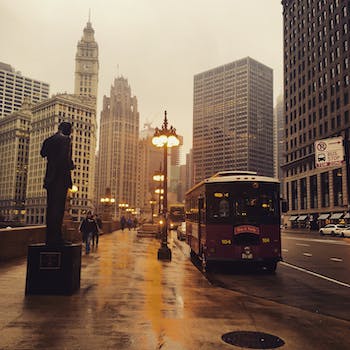

-
Table of Contents
Revisiting Jane Jacobs' Urban Insights: Reflecting on the Decline of North American Cities - Uncovering the Keys to Revitalization.
Introduction
In this paper, we will revisit the urban insights of Jane Jacobs and reflect on the decline of North American cities. Jane Jacobs was a prominent urbanist and activist who challenged conventional urban planning theories and advocated for community-based, organic development. Her ideas have had a significant impact on urban planning and continue to be relevant today. By examining the decline of North American cities through the lens of Jacobs' insights, we aim to gain a deeper understanding of the factors that have contributed to this decline and explore potential solutions for revitalization.
The Impact of Urban Renewal on North American Cities
Revisiting Jane Jacobs' Urban Insights: Reflecting on the Decline of North American Cities
The Impact of Urban Renewal on North American Cities
Urban renewal, a term coined in the mid-20th century, refers to the process of revitalizing and redeveloping urban areas. It gained popularity as a response to the decline of North American cities, which were grappling with a myriad of social, economic, and environmental challenges. However, as we reflect on the impact of urban renewal, it becomes evident that it had both positive and negative consequences for these cities.
One of the positive aspects of urban renewal was its ability to address the physical decay of urban areas. Many North American cities were plagued by dilapidated buildings, inadequate infrastructure, and overcrowding. Urban renewal projects aimed to demolish these blighted areas and replace them with modern, functional structures. This led to the creation of new housing, commercial spaces, and public amenities, which improved the overall quality of life for residents.
Moreover, urban renewal projects often sought to enhance the aesthetic appeal of cities. By demolishing old, unsightly buildings and replacing them with modern architecture, cities were able to transform their image and attract investment. This revitalization of the urban landscape helped to create a sense of pride and identity among residents, as well as attract tourists and businesses.
However, the impact of urban renewal was not uniformly positive. One of the major criticisms of this approach was its disregard for the existing communities within these urban areas. Many renewal projects involved the displacement of low-income residents, who were often unable to afford the new housing that replaced their old homes. This led to the fragmentation of communities and the loss of social cohesion.
Furthermore, urban renewal often prioritized the interests of developers and businesses over those of the local residents. This resulted in the destruction of historic neighborhoods and the erasure of cultural heritage. The focus on attracting investment and creating a modern image sometimes came at the expense of preserving the unique character and history of these cities.
Another unintended consequence of urban renewal was the exacerbation of social inequality. As low-income residents were displaced, they often found themselves pushed to the outskirts of the city, far away from job opportunities and essential services. This created a cycle of poverty and isolation, further deepening the divide between the haves and the have-nots.
In recent years, there has been a growing recognition of the limitations of urban renewal as a solution to the challenges faced by North American cities. Jane Jacobs, a prominent urbanist, argued that cities thrive when they embrace diversity, encourage small-scale development, and prioritize the needs of local communities. Her ideas have gained traction, leading to a shift in urban planning towards more inclusive and community-oriented approaches.
In conclusion, urban renewal had a significant impact on North American cities, both positive and negative. While it addressed physical decay and revitalized urban areas, it often disregarded the needs and interests of existing communities. The displacement of low-income residents, the destruction of historic neighborhoods, and the exacerbation of social inequality were unintended consequences of this approach. As we reflect on the decline of North American cities, it is crucial to learn from the mistakes of the past and embrace more inclusive and community-oriented approaches to urban development.
Jane Jacobs' Critique of Modernist Urban Planning

Jane Jacobs, a renowned urbanist and activist, made significant contributions to the field of urban planning with her critique of modernist urban planning. In her influential book, "The Death and Life of Great American Cities," Jacobs challenged the prevailing wisdom of the time and offered a fresh perspective on how cities should be designed and developed. Today, as we witness the decline of many North American cities, it is crucial to revisit Jacobs' insights and reflect on their relevance in addressing the challenges faced by urban areas.
Jacobs' critique of modernist urban planning centered around the idea that cities are complex, organic systems that cannot be effectively controlled or manipulated through top-down planning. She argued that the prevailing approach, which emphasized large-scale redevelopment projects and the separation of different land uses, was fundamentally flawed. Instead, Jacobs advocated for a more bottom-up approach that embraced the diversity and vitality of urban life.
One of Jacobs' key insights was the importance of mixed-use neighborhoods. She argued that a vibrant city requires a mix of residential, commercial, and recreational spaces, as well as a diverse range of building types and sizes. This diversity, according to Jacobs, fosters social interaction, economic activity, and a sense of community. In contrast, modernist planning often resulted in monotonous, single-use zones that lacked vitality and failed to meet the needs of residents.
Another aspect of modernist planning that Jacobs criticized was the emphasis on automobile-centric design. She argued that prioritizing cars over pedestrians and public transportation led to the destruction of urban fabric and the alienation of individuals from their surroundings. Jacobs advocated for walkable neighborhoods with well-connected streets, ample sidewalks, and a mix of transportation options. She believed that creating a pedestrian-friendly environment would not only enhance the quality of life but also promote economic activity and reduce traffic congestion.
Furthermore, Jacobs highlighted the importance of preserving existing buildings and neighborhoods. She argued that demolishing older structures and replacing them with modernist high-rises eroded the character and history of cities. Instead, Jacobs advocated for adaptive reuse and incremental development, which would allow cities to evolve organically while maintaining their unique identity. This approach, she believed, would also contribute to the affordability and diversity of housing options.
While Jacobs' ideas were met with resistance and skepticism at the time, many of her insights have since been validated by research and practical experience. Numerous cities around the world have embraced her principles and witnessed positive outcomes. For example, the revitalization of New York City's SoHo neighborhood, which was once a declining industrial area, was achieved through the preservation of historic buildings and the promotion of mixed-use development.
In conclusion, Jane Jacobs' critique of modernist urban planning remains highly relevant today as we grapple with the decline of North American cities. Her emphasis on mixed-use neighborhoods, pedestrian-friendly design, and the preservation of existing buildings offers valuable insights for addressing the challenges faced by urban areas. By revisiting Jacobs' ideas and incorporating them into our approach to urban planning, we can create cities that are vibrant, inclusive, and sustainable.
Lessons from Jane Jacobs for Sustainable Urban Development
Revisiting Jane Jacobs' Urban Insights: Reflecting on the Decline of North American Cities
Jane Jacobs, a renowned urbanist and author, made significant contributions to our understanding of cities and their development. Her groundbreaking book, "The Death and Life of Great American Cities," published in 1961, challenged prevailing urban planning theories and shed light on the decline of North American cities. Today, as we grapple with the challenges of sustainable urban development, it is crucial to revisit Jacobs' insights and draw lessons from her work.
One of Jacobs' key observations was the detrimental impact of urban renewal projects on communities. In the mid-20th century, many cities embarked on large-scale redevelopment initiatives, tearing down older neighborhoods to make way for modernist high-rise buildings and highways. Jacobs argued that these projects disrupted the social fabric of communities, displacing residents and destroying the diversity and vitality that made cities thrive.
Jacobs emphasized the importance of mixed-use neighborhoods, where residential, commercial, and recreational activities coexist. She believed that vibrant streets with a mix of shops, cafes, and public spaces fostered social interaction and created a sense of place. In contrast, single-use zoning, which separated residential areas from commercial and industrial zones, led to monotonous and isolated neighborhoods.
Furthermore, Jacobs highlighted the significance of small-scale businesses in fostering economic resilience and community cohesion. She argued that local shops and services, owned and operated by residents, were essential for creating a strong local economy. These businesses not only provided employment opportunities but also contributed to the unique character of neighborhoods.
Another crucial aspect of Jacobs' work was her emphasis on the importance of walkability and the need for safe and inviting streets. She believed that cities should be designed for pedestrians, with wide sidewalks, well-lit streets, and a mix of destinations within walking distance. Jacobs recognized that walkable neighborhoods not only promoted physical activity but also enhanced social connections and reduced reliance on cars.
In addition to her insights on urban design, Jacobs also emphasized the role of community participation in shaping cities. She advocated for bottom-up planning processes that involved residents in decision-making and encouraged grassroots initiatives. Jacobs believed that local knowledge and the collective wisdom of communities were invaluable resources for creating livable and sustainable cities.
As we reflect on Jacobs' work, it is clear that her insights remain highly relevant today. Many North American cities continue to face challenges related to urban decline, gentrification, and environmental sustainability. By embracing Jacobs' principles, we can chart a path towards more inclusive, resilient, and sustainable urban development.
To apply Jacobs' lessons, city planners and policymakers must prioritize community engagement and involve residents in shaping their neighborhoods. This can be achieved through participatory planning processes, community-led initiatives, and the preservation of historic buildings and cultural heritage.
Furthermore, cities should prioritize mixed-use development and walkability. By creating vibrant, diverse neighborhoods with a mix of housing, businesses, and amenities, we can foster social interaction, support local economies, and reduce car dependency. Investing in pedestrian-friendly infrastructure, such as wider sidewalks, bike lanes, and public transit, will also contribute to more sustainable and livable cities.
In conclusion, Jane Jacobs' insights on urban development continue to resonate today. Her observations on the detrimental effects of urban renewal, the importance of mixed-use neighborhoods, the vitality of small-scale businesses, the need for walkability, and the value of community participation provide valuable lessons for sustainable urban development. By embracing these principles, we can create cities that are not only environmentally sustainable but also socially vibrant and economically resilient.
Q&A
1. What were some of Jane Jacobs' key insights about urban decline in North American cities?
Jane Jacobs highlighted the importance of mixed-use neighborhoods, pedestrian-friendly streets, and diverse local economies as key factors in maintaining vibrant and thriving cities.
2. How did Jane Jacobs' ideas challenge conventional urban planning practices?
Jacobs challenged the prevailing belief in urban renewal and large-scale redevelopment projects, advocating instead for preserving existing neighborhoods and promoting community involvement in decision-making processes.
3. Have North American cities successfully implemented Jane Jacobs' ideas to combat urban decline?
While some cities have embraced Jacobs' ideas and implemented policies to promote mixed-use neighborhoods and pedestrian-friendly streets, challenges remain. Many cities still struggle with issues such as gentrification, suburban sprawl, and the loss of local businesses, indicating that the full implementation of Jacobs' insights is a work in progress.
Conclusion
In conclusion, revisiting Jane Jacobs' urban insights provides valuable reflections on the decline of North American cities. Her observations and theories continue to hold relevance in understanding the challenges faced by urban areas. By emphasizing the importance of diverse and vibrant neighborhoods, community engagement, and mixed-use development, Jacobs' ideas offer potential solutions for revitalizing and sustaining cities in the face of decline. As urban planners and policymakers continue to grapple with urban challenges, Jacobs' work serves as a valuable resource for shaping future urban development strategies.












